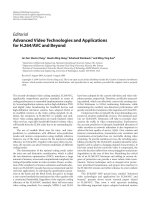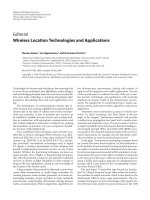xml technologies and applications
Bạn đang xem bản rút gọn của tài liệu. Xem và tải ngay bản đầy đủ của tài liệu tại đây (215.04 KB, 48 trang )
XML Technologies and Applications
Rajshekhar Sunderraman
Department of Computer Science
Georgia State University
Atlanta, GA 30302
II. XML Structural Constraint Specification
(DTDs and XML Schema)
December 2005
December 2005
Outline
Introduction
XML Basics
XML Structural Constraint Specification
Document Type Definitions (DTDs)
XML Schema
XML/Database Mappings
XML Parsing APIs
Simple API for XML (SAX)
Document Object Model (DOM)
XML Querying and Transformation
XPath
XQuery
XSLT
XML Applications
Document Type Definitions (DTDs)
DTD: Document Type Definition; A way to specify the
structure of XML documents.
A DTD adds syntactical requirements in addition to the well-
formed requirement.
DTDs help in
Eliminating errors when creating or editing XML documents.
Clarifying the intended semantics.
Simplifying the processing of XML documents.
Uses “regular expression” like syntax to specify a grammar
for the XML document.
Has limitations such as weak data types, inability to specify
constraints, no support for schema evolution, etc.
Example: An Address Book
<person>
<name> Homer Simpson </name>
<greet> Dr. H. Simpson </greet>
<addr>1234 Springwater Road </addr>
<addr> Springfield USA, 98765 </addr>
<tel> (321) 786 2543 </tel>
<fax> (321) 786 2544 </fax>
<tel> (321) 786 2544 </tel>
<email> </email>
</person>
Mixed telephones and
faxes
As many as
needed
As many address lines
as needed (in order)
At most one greeting
Exactly one name
Specifying the Structure
name
a name element
greet?
an optional (0 or 1) greet elements
name, greet?
a name followed by an optional greet
addr*
to specify 0 or more address lines
tel | fax
a tel or a fax element
(tel | fax)*
0 or more repeats of tel or fax
email*
0 or more email elements
Specifying the Structure (continued)
So the whole structure of a person entry is specified by
name, greet?, addr*, (tel | fax)*, email*
Regular expression syntax (inspired from UNIX regular
expressions)
Each element type of the XML document is described by an
expression (the leaf level element types are described by the
data type (PCDATA)
Each attribute of an element type is also described in the DTD
by enumerating some of its properties (OPTIONAL, etc.)
Element Type Definition
For each element type E, a declaration of the form:
<!ELEMENT E content-model>
where the content-model is an expression:
Content-model ::=
EMPTY | ANY | #PCDATA | E’ |
P1, P2 | P1 | P2 | P1? | P1+ | P1* | (P)
–
E’ element type
–
P1 , P2 concatenation
–
P1 | P2 disjunction
–
P? optional
–
P+ one or more occurrences
–
P* the Kleene closure
–
(P) grouping
Element Type Definition
The definition of an element consists of exactly one of the
following:
A regular expression (as defined earlier)
EMPTY: element has no content
ANY: content can be any mixture of PCDATA and
elements defined in the DTD
Mixed content which is defined as described on the
next slide
(#PCDATA)
The Definition of Mixed Content
Mixed content is described by a repeatable OR group
(#PCDATA | element-name | …)*
Inside the group, no regular expressions – just element
names
#PCDATA must be first followed by 0 or more element
names, separated by |
The group can be repeated 0 or more times
Address-Book Document with an Internal DTD
<?xml version="1.0" encoding="UTF-8"?>
<!DOCTYPE addressbook [
<!ELEMENT addressbook (person*)>
<!ELEMENT person (name, greet?, address*,
(fax | tel)*, email*)>
<!ELEMENT name (#PCDATA)>
<!ELEMENT greet (#PCDATA)>
<!ELEMENT address (#PCDATA)>
<!ELEMENT tel (#PCDATA)>
<!ELEMENT fax (#PCDATA)>
<!ELEMENT email (#PCDATA)>
]>
The Rest of the Address-Book Document
<addressbook>
<person>
<name>Jeff Cohen</name>
<greet> Dr. Cohen</greet>
<email></email>
</person>
</addressbook>
Some Difficult Structures
Each employee element should contain name, age and ssn
elements in some order
<!ELEMENT employee
((name, age, ssn) | (age, ssn, name) |
(ssn, name, age) |
)>
Too many permutations!
Attribute Specification in DTDs
<!ELEMENT height (#PCDATA)>
<!ATTLIST height
dimension CDATA #REQUIRED
accuracy CDATA #IMPLIED >
The
dimension
attribute is required
The
accuracy
attribute is optional
CDATA is the “type” of the attribute – character data
The Format of an Attribute Definition
<!ATTLIST element-name attr-name attr-type
attr-default>
The default value is given inside quotes
Attribute types:
CDATA
ID, IDREF, IDREFS
ID, IDREF, IDREFS
are used for references
Attribute Default
#REQUIRED: the attribute must be explicitly provided
#IMPLIED: attribute is optional, no default provided
"
value
": if not explicitly provided, this value inserted by default
#FIXED "
value
": as above, but only this value is allowed
Recursive DTDs
<DOCTYPE genealogy [
<!ELEMENT genealogy (person*)>
<!ELEMENT person (
name,
dateOfBirth,
person, mother
person )> father
]>
Problem with this DTD: Parser does not see the recursive
structure and looks for “person” sub-element
indefinitely!
Recursive DTDs (cont’d)
<DOCTYPE genealogy [
<!ELEMENT genealogy (person*)>
<!ELEMENT person (
name,
dateOfBirth,
person?, mother
person? )> father
]>
The problem with this DTD is if only one “person” sub-
element is present, we would not know if that person is
the father or the mother.
Using ID and IDREF Attributes
<!DOCTYPE family [
<!ELEMENT family (person)*>
<!ELEMENT person (name)>
<!ELEMENT name (#PCDATA)>
<!ATTLIST person
id ID #REQUIRED
mother IDREF #IMPLIED
father IDREF #IMPLIED
children IDREFS #IMPLIED>
]>
IDs and IDREFs
ID
attribute: unique within the entire document.
An element can have at most one ID attribute.
No default (fixed default) value is allowed.
#required: a value must be provided
#implied: a value is optional
IDREF attribute: its value must be some other element’s ID
value in the document.
IDREFS attribute: its value is a set, each element of the set
is the ID value of some other element in the document.
<person id=“898” father=“332” mother=“336”
children=“982 984 986”>
Some Conforming Data
<family>
<person id=“lisa” mother=“marge” father=“homer”>
<name> Lisa Simpson </name>
</person>
<person id=“bart” mother=“marge” father=“homer”>
<name> Bart Simpson </name>
</person>
<person id=“marge” children=“bart lisa”>
<name> Marge Simpson </name>
</person>
<person id=“homer” children=“bart lisa”>
<name> Homer Simpson </name>
</person>
</family>
Limitations of ID References
The attributes mother and father are references to IDs of
other elements.
However, those are not necessarily person elements!
The mother attribute is not necessarily a reference to a
female person.
An Alternative Specification
<?xml version="1.0" encoding="UTF-8"?>
<!DOCTYPE family [
<!ELEMENT family (person)*>
<!ELEMENT person (name, mother?, father?,
children?)>
<!ATTLIST person id ID #REQUIRED>
<!ELEMENT name (#PCDATA)>
<!ELEMENT mother EMPTY>
<!ATTLIST mother idref IDREF #REQUIRED>
<!ELEMENT father EMPTY>
<!ATTLIST father idref IDREF #REQUIRED>
<!ELEMENT children EMPTY>
<!ATTLIST children idrefs IDREFS #REQUIRED>
]>
Empty sub-elements instead of attributes
The Revised Data
<family>
<person id="marge">
<name>Marge Simpson</name>
<children
idrefs="bart lisa"/>
</person>
<person id="homer">
<name>Homer Simpson</name>
<children
idrefs="bart lisa"/>
</person>
<person id="bart">
<name>Bart Simpson</name>
<mother idref="marge"/>
<father idref="homer"/>
</person>
<person id="lisa">
<name>Lisa Simpson</name>
<mother idref="marge"/>
<father idref="homer"/>
</person>
</family>
Consistency of ID and IDREF Attribute Values
If an attribute is declared as ID
The associated value must be distinct, i.e., different elements
(in the given document) must have different values for the ID
attribute.
Even if the two elements have different element names
If an attribute is declared as IDREF
The associated value must exist as the value of some ID
attribute (no dangling “pointers”)
Similarly for all the values of an IDREFS attribute
ID, IDREF and IDREFS attributes are not typed
Adding a DTD to the Document
A DTD can be
internal
The DTD is part of the document file
external
The DTD and the document are on separate files
An external DTD may reside
In the local file system (where the document is)
In a remote file system
Connecting a Document with its DTD
An internal DTD
<?xml version="1.0"?>
<!DOCTYPE db [<!ELEMENT > … ]>
<db> </db>
A DTD from the local file system:
<!DOCTYPE db SYSTEM "schema.dtd">
A DTD from a remote file system:
<!DOCTYPE db SYSTEM
" />









